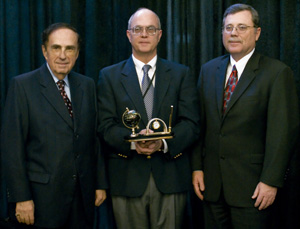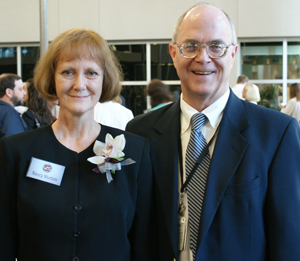 |
James Armitage, M.D., center, with UNMC Chancellor Harold M. Maurer, M.D., left, and Joe Graham, chief operating officer of The Nebraska Medical Center, displays a keepsake he was given to commemorate his founding of the medical center’s bone marrow and stem cell transplant program 25 years ago. |
UNMC and its hospital partner, The Nebraska Medical Center, are celebrating a significant milestone this year.
The bone marrow and stem cell transplant program at the medical center, known for its innovation and success in stem cell transplantation, is celebrating its 25-year anniversary.
The program was founded in 1983 by James Armitage, M.D., Shapiro Professor of Medicine at UNMC and hematologist/oncologist at The Nebraska Medical Center, who is world renowned for his clinical research in lymphoma and bone marrow and stem cell transplantation.
“Jim and his team always wanted the transplant program to be the best in the world and it has become the best,” UNMC Chancellor Harold M. Maurer, M.D., said Wednesday at a ceremony commemorating the program’s 25th anniversary. “(The program is made up of a) marvelous team of people that cannot be duplicated very easily anywhere else.”
Drawing patients from around the world, the program is ranked as one of the busiest adult lymphoma and pediatric programs in the country. The program averages 150 transplants a year and has performed more than 4,000 transplants since its founding.
There are many reasons why people come from around the world to receive care from the medical center’s transplant program.
Since its founding 25 years ago, physicians and researchers in the program have been pioneers in the field and have been recognized internationally for a number of ground-breaking advancements.
These advancements have helped improve success rates and have made bone marrow and stem cell transplants a more viable and promising option for a growing number of patients. This includes those with malignancies that include primarily lymphomas, leukemias, multiple myeloma as well as some blood disorders.
The first of these revolutionary achievements was the study and introduction of autogolous transplantation by Dr. Armitage and his colleagues, which served as the starting point and foundation for the program’s success.
“At the time, bone marrow transplants were still a very new thing,” Dr. Armitage said. “Allogeneic transplants, in which stem cells are harvested from a donor, were increasingly being done, but they were quite dangerous and risky. We wanted to find a way to help people who had otherwise incurable lymphoma. So we developed a hypothesis and began testing autogolous transplants as another option for these people.”
Autogolous transplants involve using the patient’s own stem cells, which reduces the complexity of the procedure and eliminates rejection issues such as graft versus host disease. This condition, which Dr. Armitage said occurs in more than half of all allogeneic transplants, happens when the new immune cells recognize that they are not in the right body and attack the other cells of the body.
Today, autogolous transplants are the preferred form of transplantation for more than 75 percent of lymphoma patients, he said.
Another milestone in the field of bone marrow and stem cell transplantation was the development of stem cell transplantation, which was introduced in 1984 by Anne Kessinger, M.D., professor of oncology/hematology at UNMC and a hematologist/oncologist at The Nebraska Medical Center.
The use of peripheral blood-derived stem cells, as opposed to bone marrow-derived stem cells, has become the standard of care for transplantation. This has helped improve outcomes for autogolous transplant patients, contributed to much quicker recovery times and decreased infection rates.
Peripheral blood-derived stem cell transplant is similar to bone marrow transplant except the cells are collected from those circulating in the blood rather than bone marrow. Bone marrow is the spongy tissue found inside the bones. It produces the body’s blood cells and cells of the immune system. The blood cells of the bone marrow, white blood cells, red blood cells, platelets and others, all come from one type of cell called the stem cell.
The process for removing stem cells is much easier, quicker and more comfortable for the patient, said Julie Vose, M.D., chief of hematology/oncology at UNMC. For instance, bone marrow removal required general anesthesia and was performed by using numerous needles to inject the patient until enough marrow had been withdrawn.
In comparison, stem cells are removed during a two- to three-hour procedure in which a catheter is placed into the chest and inserted into a large blood vessel. The blood is circulated through a special machine that separates out the stem cells from the rest of the blood. The stem cells are then frozen and stored until they are ready to be re-infused back into the patient.
|
|
“By being able to stimulate and increase the growth of stem cells after transplant, today we are seeing decreased infections, lower death rates, fewer transfusions and reduced recovery time in the hospital,” Dr. Vose said.
Other important treatment advancements that have had a significant impact in improving the outcomes for patients, Dr. Vose said, include improvements in supportive care techniques, anti-rejection medications and the ability to prevent and treat complications, especially infections.
“Twenty years ago, 30 to 40 percent of adult patients died from complications of an autogolous transplant,” she said. “Today, that number is down to 1 to 2 percent.”
In addition, adult transplant candidates used to be limited to those younger than 60 years of age. Today, transplants are performed on individuals as old as 75 years old. Survival rates average 50 to 60 percent, depending on the type of malignancy, compared to approximately 20 to 40 percent 10 years ago.
“Research is critical,” Dr. Armitage said. “As leaders in research, we are able to offer our patients new and promising therapies before anyone else. You can either watch others do it or you can be the ones doing it, and we are definitely leaders in this area.”
Pediatric transplants are another component of the bone marrow and stem cell transplant program. Started in 1987 by Peter Coccia, M.D., vice chairman of the department of pediatrics at UNMC and chief of pediatric hematology/oncology at The Nebraska Medical Center, the program has performed more than 335 transplants. Transplants in the pediatric population are normally reserved for patients with more aggressive disease and are far less common than adult transplants.
The majority of pediatric transplants are performed on patients with acute lymphoblastic leukemia. More than 80 percent of these patients will be cured with conventional chemotherapy, said Al Grovas, M.D., hematologist/oncologist at UNMC and The Nebraska Medical Center and clinical director for the pediatric bone marrow and stem cell transplant program, leaving about 20 percent of patients who will need a stem cell transplant.
“The knowledge curve has risen steadily since the first pediatric transplant in 1987,” Dr. Grovas said. “And with that, improved success rates have followed suit.
“The Nebraska Medical Center program is unique in that it shares the same transplant unit as the adult program. This provides us the advantage of sharing all of the same resources and the expertise of our experienced nursing staff and other health care professionals.”
 |
Dr. Armitage with Nancy Wurtele of Nebraska City, who was the second person to receive a transplant through the bone marrow and stem cell transplant program. |
Through this network, doctors can study and refine their techniques to diagnose, treat and follow patients to provide them with optimal care.
The medical center’s program is the only one of its kind in the region, said Theresa Franco, executive director of the cancer program.
“We have experienced physicians focused around specific diseases, an investigational mentality and pioneering treatments,” she said. “We have built this program on total commitment, total expertise and total engagement of our patients and families.”
Dr. Armitage said his ultimate hope is that the bone marrow and stem cell transplant program will some day go out of business.
“Because that would mean that we had learned enough about treating these cancers that patients would no longer need transplants,” he said.
And you can be sure that Dr. Armitage and researchers at UNMC and The Nebraska Medical Center will have played a major role in that scenario should it some day come to fruition.